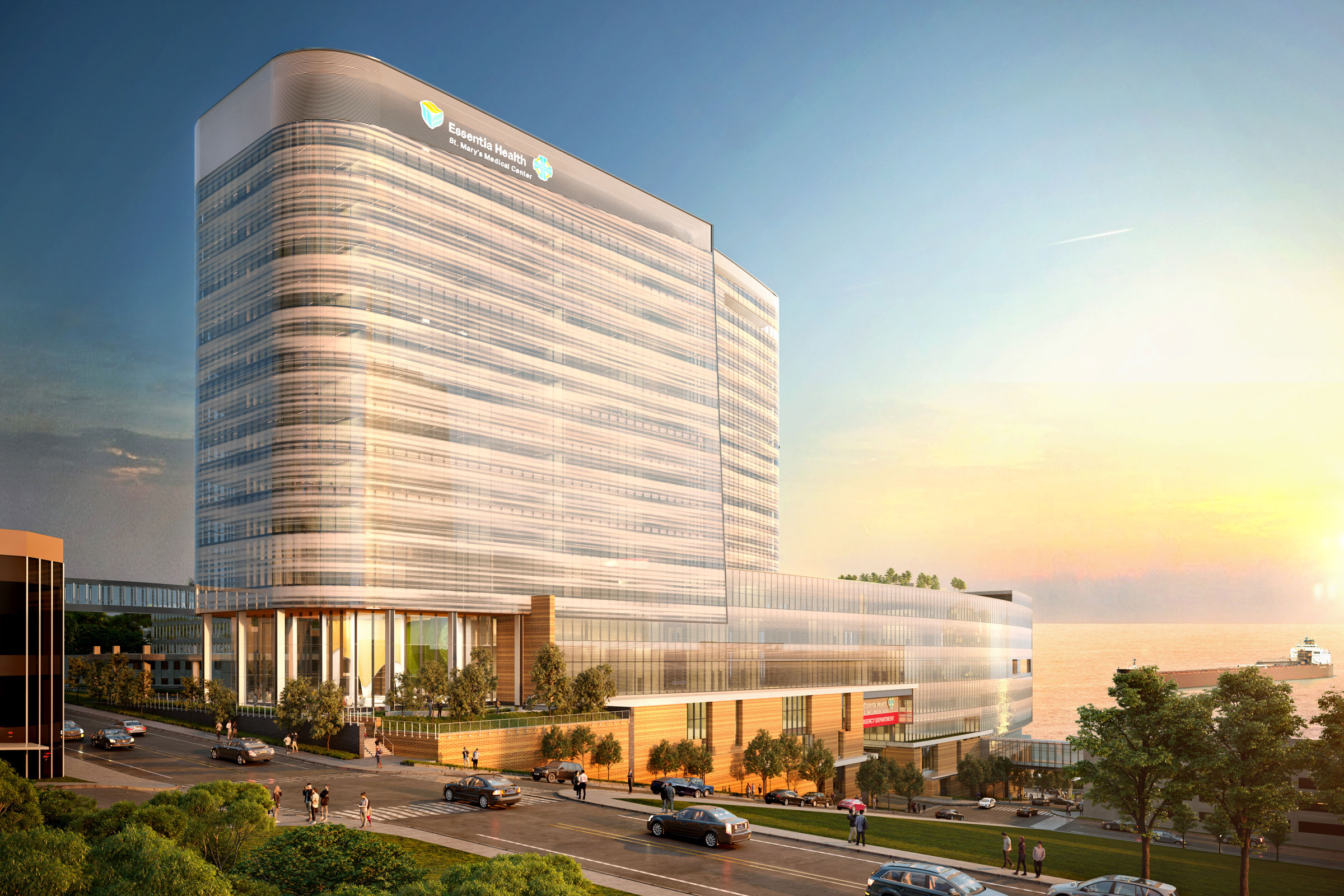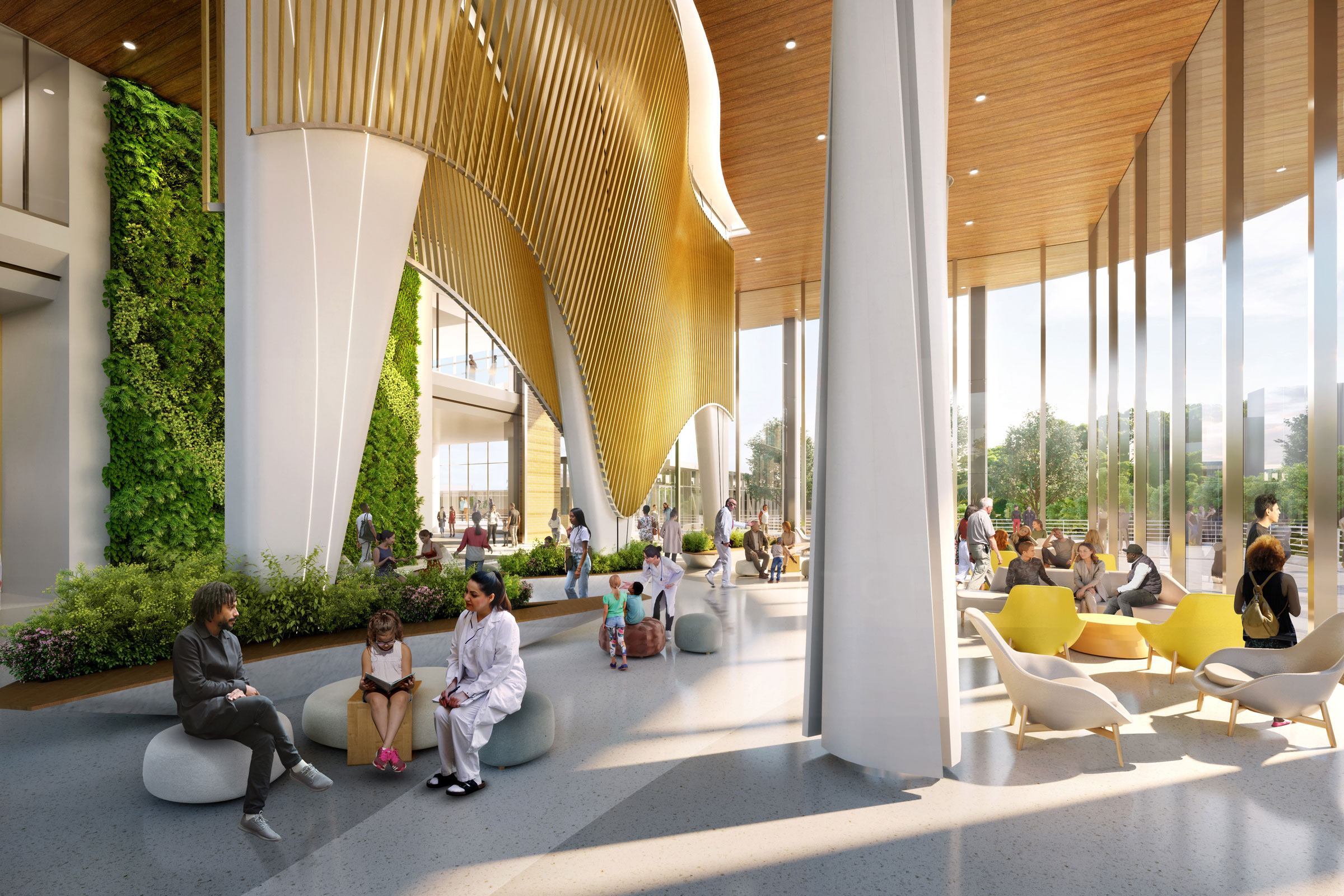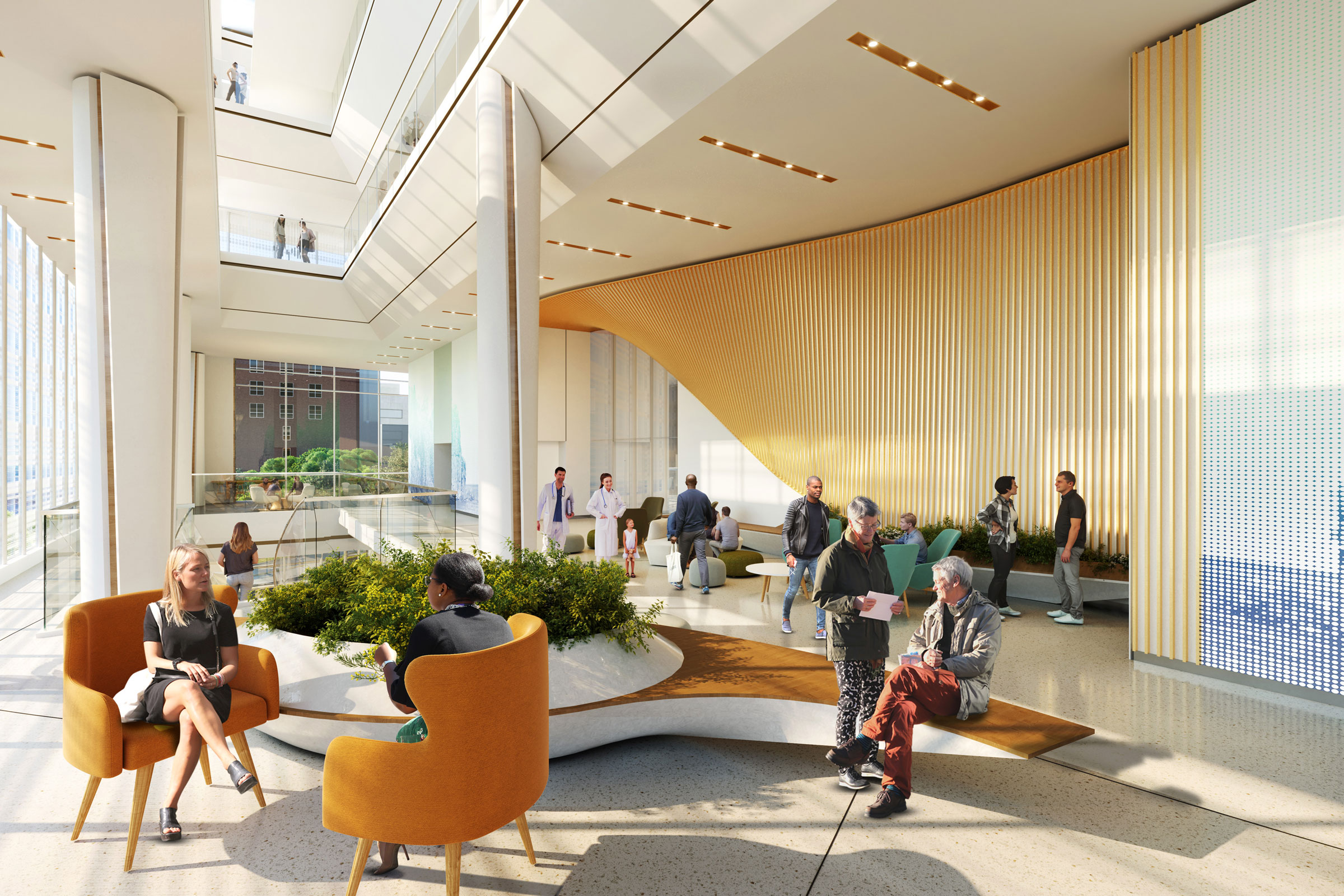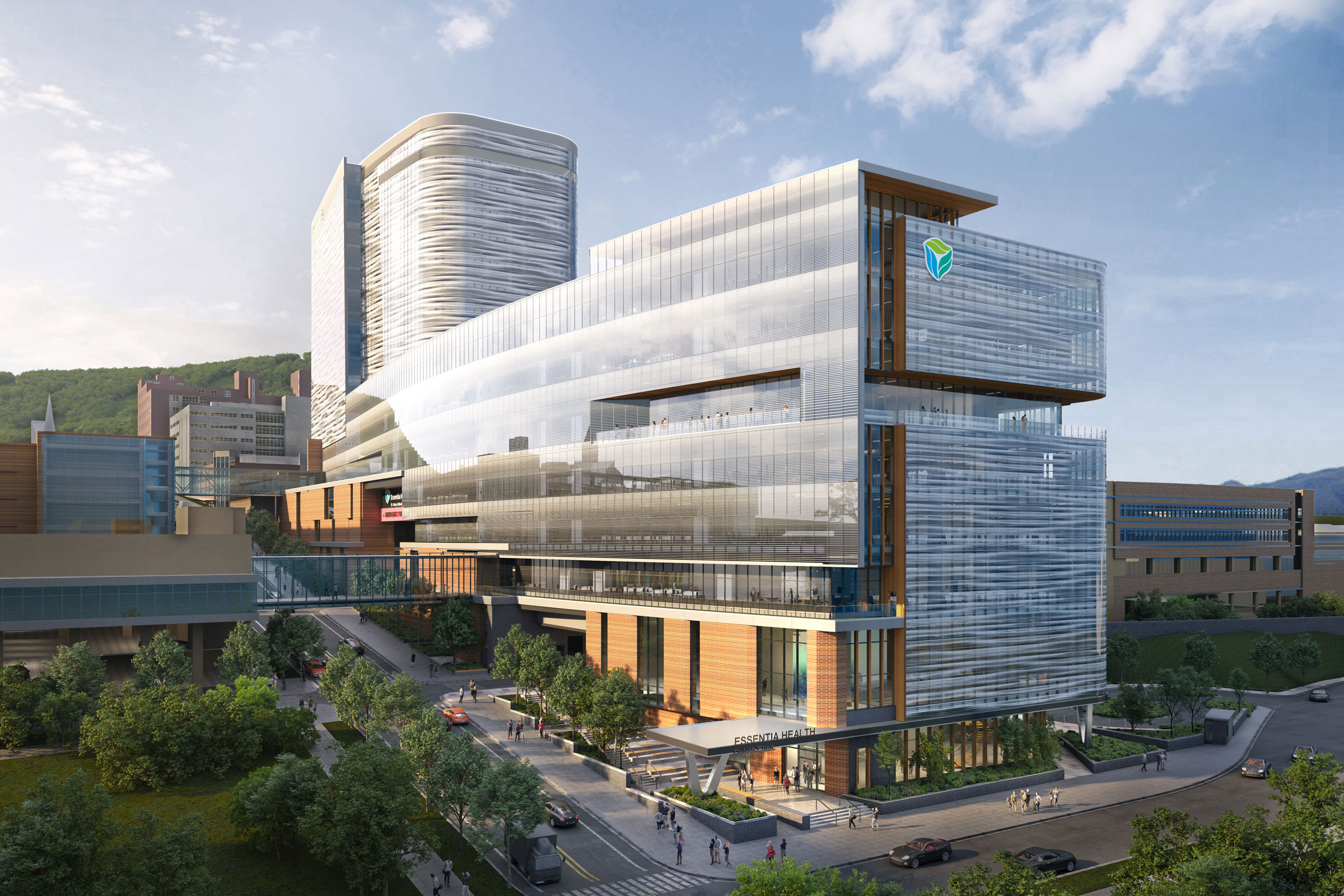Story at a glance:
- EwingCole designed a 950,000 square-foot hospital in Duluth, Minnesota.
- The team attempted to reduced embodied and operational carbon through design and material selection.
- The project draws on biophilic design, which can accelerate recovery time, benefit sleep cycles, and improve cognitive performance.
When Essentia Health partnered with EwingCole to design its new hospital in Duluth, Minnesota, they presented them with a monumental task: revolutionize the health care delivery system in northern Minnesota with a facility that invigorates a local economy and supports a growing health care need across the region.
An expert in health care design and no stranger to large-scale, commercial, and sustainable projects, EwingCole’s design team envisioned a facility that supports increased patient volumes as well as the natural fabric of the surrounding environment. After in-depth exploration, planning, and discussions with stakeholders from staff and administrators to community members and patients, the design team developed a high-performing hospital with an aesthetically modern, streamlined design that weaves into the fabric of the surrounding landscape and urban layout.
At 950,000 square feet, the $800 million Vision Northland (VN) spans several city streets and consolidates critical health care services, creating innumerable opportunities for Essentia Health. Positioned on the banks of Lake Superior, the building’s interior and exterior design is inspired by both the natural and urban textures of Duluth. The exterior brick along the building podium mimics the surrounding neighborhoods, while the patient tower exterior fritted glass resembles the fog rolling off the lake. Inside, its patient-centric interiors are designed to foster positive patient outcomes with natural materials and nature-focused imagery and by consolidating critical care components such as adaptable inpatient rooms, procedure rooms and OR platforms, and flexibly planned outpatient spaces.
Values-based Design
VN is founded on Essentia’s values of creating healthier communities with its roots in sustainability. Essentia’s administration believes that health care facilities should support the health and wellness of an entire community, not just through its services but through the relationship between the built environment and the surrounding ecology.
To meet Essentia’s specific sustainability goals, EwingCole relied on several frameworks to serve as toolkits of proven market-appropriate strategies, resulting in what the team called the Vision Northland Sustainability Criteria. This specifically tailored framework allowed the design team the flexibility to navigate between building program needs and sustainability performance goals. These strategies will reduce energy consumption, water usage, and VN’s embodied carbon footprint and create an interior environment that supports patient health and wellbeing.
Future Climate Performance Improvement

Rendering courtesy of EwingCole
Hospitals are among the top two energy consumers by building type. To mitigate VN’s impacts on carbon emissions from operational energy use and life-cycle costs, EwingCole integrated energy modeling at the earliest design stages. Everything from the exterior envelope to the HVAC systems and lighting was selected based on rigorous simulation performance modeling.
An integrated team consisting of EwingCole’s architects and engineers and an envelope consultant and envelope fabricator came together to make sure that the building envelope performed as designed. Envelope performance is critical with a building of this scale, located in an extreme weather environment like Duluth. A full-scale mockup of the building envelope was constructed and rigorously tested to allow the team to detect even the smallest amount of air and moisture infiltration which left unchecked could significantly affect the building’s overall energy performance and indoor air quality.
As a result of these efforts, the design team achieved a 24% reduction in energy consumption and a 26% reduction in energy costs.
These savings are part of a targeted strategy to reduce operational carbon – or the carbon emitted from running the building. To further reduce the building’s overall carbon emissions, the design team turned to a reduction in embodied carbon—emissions from the manufacturing, transportation, installation, maintenance, and disposal of building materials. The embodied carbon footprint is established on day one, while the operational carbon footprint accrues over time. Even with the continuous growth of the operational carbon footprint, embodied carbon makes up over half of the total carbon emissions from a new building in the first 20 years of operation. By focusing on reducing operational and embodied carbon, we can drive down built environment GHG emissions further than ever before.
Structural materials, such as concrete and steel, make up the most significant fraction of embodied carbon in buildings. Reductions in the embodied carbon of concrete targeted replacement of Portland cement, the concrete component responsible for much of its embodied carbon. Cement substitutes reduced embodied carbon and improved the performance characteristics for certain uses of concrete in the foundations. For the steel, the team focused on validating high recycled content and optimizing member sizing and quantity. The building form was optimized based on a series of wind tests. As the form was refined to reduce wind resistance, the structural system could also be refined, requiring less steel volume to support the building.
Supporting Healthy Environments
When designing sustainable health care facilities, EwingCole’s team focuses on overall human wellness as much as building energy performance. We define wellness as a state of being and a process that aims to achieve a whole person’s health, or in this case, a patient’s. To support that process, optimizing the materials surrounding patients and making up the indoor environment is the highest priority. To this end, the team focused on three large-volume, high-contact material categories: the ceilings, flooring, and wall protection.
For each category, two additional criteria were used to evaluate materials for inclusion in the project: VOC emissions testing and material ingredient disclosure. Volatile organic compounds (VOC) can be emitted, or off-gas, from building materials, negatively impacting air quality and human health. VOC emissions testing verifies that select materials produce little to no emissions. Products were also selected based on their material ingredient disclosures. Like a nutrition label on a food product, these disclosures show the exact chemical makeup of each product, allowing the team to review potentially hazardous ingredients and determine which materials are more appropriate for the space.
Nature is Healing

Rendering courtesy of EwingCole
Our mental and physical health is directly tied to our connection with the natural world. Research shows that being in or directly viewing nature can accelerate recovery time, benefit sleep cycles, and improve cognitive performance. This is a key driver behind the exterior glazing of the patient tower. VN’s glass envelope provides nearly 360-degree access to natural light, supporting patients’ natural circadian rhythms, the body’s internal clock and an essential component of every person’s health and wellbeing. One of the key features of the design, the outdoor roof terrace, provides patients and visitors with the opportunity to take in breathtaking views of Lake Superior and connect them with the outdoors without leaving the building site.
Biophilic design, which supports our innate connection to nature, was also a guiding strategy for VN. The design team included an abundance of opportunities for plant life within the hospital and the use of natural materials such as wood and stone. But biophilic design goes much deeper than just greenery. Less obvious aspects of biophilic design include space layout. We may not cognitively recognize certain layouts as “natural,” but they are also innate to us. For example, having places of refuge and comfort and seeing out into the space around us allow inhabitants to relax and reduce stress levels.
Environment, Economy, Equity

Rendering courtesy of EwingCole
From day one, the support of regional industry, craft, and economy was a primary goal for Essentia Health. Selecting materials based on the three pillars of sustainability—environment, economy, and equity—helped the design team meet this goal. Sourcing regional materials supports the community that Essentia Health serves, building local economies and pride of place. It also reduces travel distances for materials from the manufacturing site to the installation site, cutting GHG emissions and protecting the environment.
For the biggest impact, the team focused on selecting larger volume materials to source regionally, rather than only small-volume specialty pieces that are more commonly locally sourced. The glass curtain wall was manufactured by a company 230 miles from the VN site. Creating a custom glazing system often involves a global supply chain of multiple manufacturers and many transitions from one location to another. EwingCole selected a single-source, local manufacturer that could pull many manufacturing process steps together in one location, decreasing transportation emissions and supporting the local economy.
Additionally, most of the acoustic ceiling panels in the building—nearly 1 million square feet of them—are manufactured roughly 30 minutes away from VN, reducing travel time and GHG and supporting the local economy. Lastly, the structural steel is all sourced in the United States. Steel is a commonly recycled product, and because the material was US-sourced, the design team was able to scrutinize its sourcing and contents, leading to the procurement of 90-95% recycled steel.
Spirit of Place
Ensuring that the new hospital was of its place and embedded in its community was also a high priority. As discussed above, that spirit of place comes into VN through its access to nature, views of nature, and nature within the building. It is also the foundation of an extensive interior graphics package. These graphics highlight local landmarks, regional history, flora, and fauna native to the North Shore and familiar to the local community. The graphics are tailored for each floor, some directly representing these elements and others in more abstracted patterns and colors. These beautiful images support patients, family, and staff by building familiarity and comfort and serve the essential purpose of wayfinding throughout the building.




